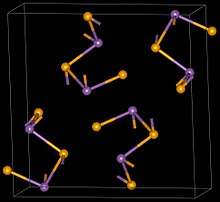Antimony triselenide
 | |
| Names | |
|---|---|
| Other names
antimonselite selenoxyantimony | |
| Identifiers | |
3D model (JSmol) |
|
| ChemSpider | |
| ECHA InfoCard | 100.013.870 |
PubChem CID |
|
| |
| |
| Properties | |
| Sb2Se3 | |
| Molar mass | 480.4 g/mol |
| Appearance | black crystals |
| Density | 5.81 g/cm3, solid |
| Melting point | 611 °C (1,132 °F; 884 K) |
| Structure | |
| Orthorhombic, oP20, SpaceGroup = Pnma, No. 62 | |
| Hazards | |
| US health exposure limits (NIOSH): | |
PEL (Permissible) |
TWA 0.5 mg/m3 (as Sb)[1] |
REL (Recommended) |
TWA 0.5 mg/m3 (as Sb)[1] |
| Related compounds | |
Other anions |
antimony(III) oxide, antimony(III) sulfide, antimony(III) telluride |
Other cations |
arsenic(III) selenide, bismuth(III) selenide |
Except where otherwise noted, data are given for materials in their standard state (at 25 °C [77 °F], 100 kPa). | |
| Infobox references | |
Antimony triselenide is the chemical compound with the formula Sb2Se3. The material exists as the sulfosalt mineral antimonselite, which crystallizes in an orthorhombic space group.[2] In this compound, antimony has the oxidation state +3 and selenium −2, but in fact the bonding in this compound is highly covalent as reflected by the black color and semiconducting properties of this and related materials.[3]
Applications
Sb2Se3 is now actively explored for thin film solar cells and have achieved 6.5% certified efficiency.
References
- 1 2 "NIOSH Pocket Guide to Chemical Hazards #0036". National Institute for Occupational Safety and Health (NIOSH).
- ↑ Jambor, J. L.; Grew, E. S."New Mineral Names" American Mineralogist, Volume 79, pages 387-391, 1994.
- ↑ Caracas, R.; Gonze, X. "First-principles study of the electronic properties of A2B3 minerals,, with A=Bi,Sb and B=S,Se, Note: Hypothetical sulphosalt structure derived from density functional theory"" Physics and Chemistry of Minerals 2005, volume 32 p.295-300.
This article is issued from
Wikipedia.
The text is licensed under Creative Commons - Attribution - Sharealike.
Additional terms may apply for the media files.